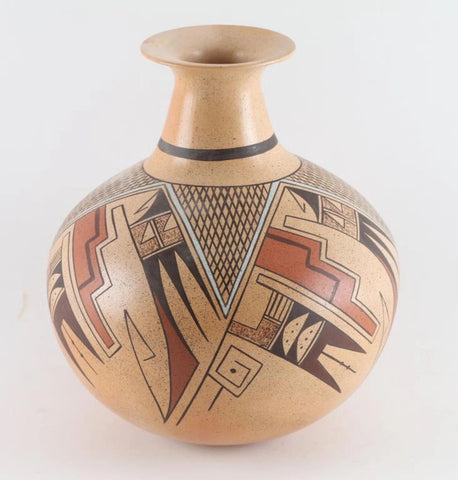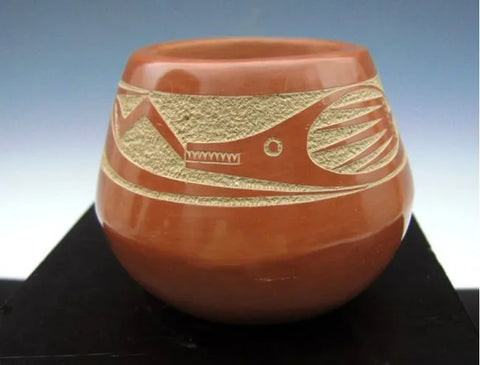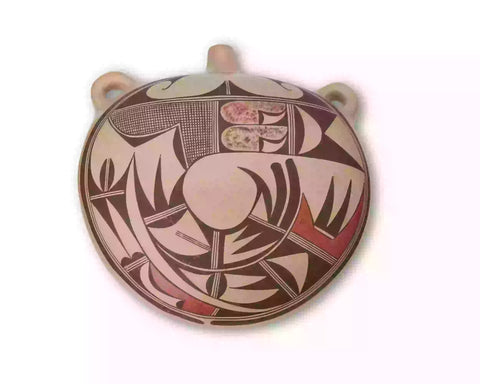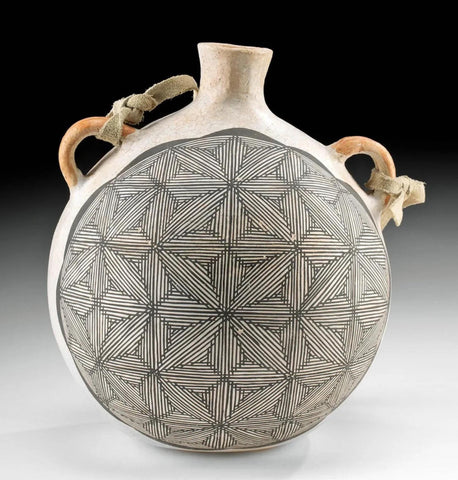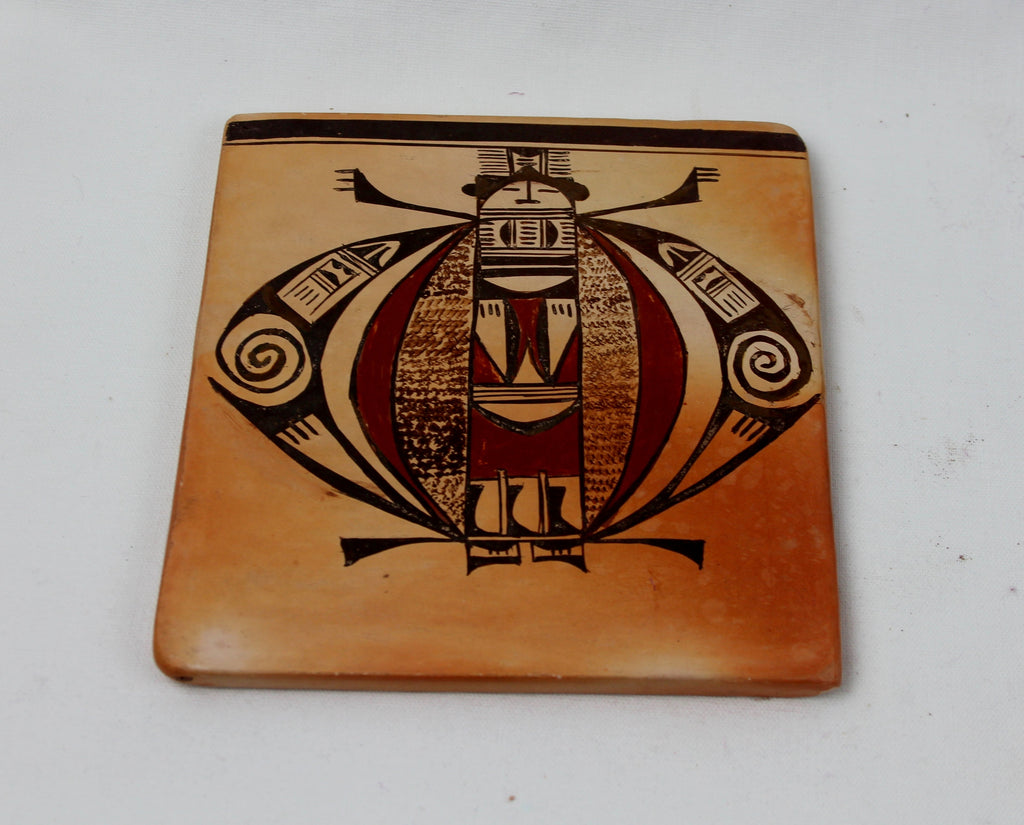
Native American, Vintage Hopi Pottery Tile with Katsina, by Priscilla Namingha Nampeyo, Ca 1940's, #1208 Sold
$ 250.00
Native American,
Vintage Hopi Pottery Tile with Katsina, by Priscilla Namingha Nampeyo, Ca 1940's, #1208
Description: #1208 Native American, Vintage Hopi Pottery Tile with Katsina, by Priscilla Namingha Nampeyo, Ca !940's
Dimensions: 4.5" x 4.75".
Condition: Very good for age, back lower corner has a small chip out of it.
Priscilla Namingha Nampeyo (1924-2008) was a Hopi-Tewa potter of the Nampeyo family tradition. She made pottery beginning from when her great grandmother Nampeyo of Hano started teaching her at seven years old and she continued almost to the day she died. Nampeyo of Hano (1860-1942) is the famous Hopi-Tewa potter who revitalized Hopi pottery by creating a contemporary style inspired by the ancient designs found on pottery shards from the prehistoric pueblo of Sikyatki. Priscilla is the daughter of Rachel Namingha Nampeyo and Emerson Namingha, granddaughter of Annie Healing Nampeyo and Will Healing. In that respect, Priscilla grew up in the heart of a Hopi pottery dynasty.
Priscilla's pottery styles include black-and-red-on-yellow jars, bowls, wedding vases, piki bowls and miniatures. She makes her pottery using the traditional methods she learned from her great-grandmother Nampeyo and she still uses many of Nampeyo's designs. Among her favorite designs are migration pattern, eagle tails, dragonflies, birds, stars, feathers, and clouds.
Priscilla passed her knowledge of the art of making traditional pottery to her children and some of those are active today, including: Jean Sahmie, Randy Sahmie, Nyla Sahmie, Rachel Sahmie and Bonnie Chapella Nampeyo. All are award-winning potters in their own right. (Source: House of Charuut)
Hopi Pottery Tiles
Hopi pottery tiles had their beginning as utilitarian objects by the potters of the villages. In making pottery vessels, it is imperative to add a tempering agent to the clay for strength. Occasionally, sand was used as a tempering agent, but more often the potters chose to use fragments of broken pottery. There were times when broken fragments were in short supply, so the potters fashioned square tiles of clay, fired them, then ground them to the fineness of sawdust, and that was their temper.
Thomas V. Keam, an early trader to the Hopi, described this process in his diary. “... the Moki women made frequent reference to the method anciently employed to produce a paste of compact and equable texture, by first molding the clay into tiles, which, after baking, were ground into a fine powder.”
Keam was a very astute businessman. He saw the potential for converting these tiles into items that would be saleable to tourists. Keam started collecting decorated tiles as early as 1880. All the early tiles were decorated with Katsina faces or, in some cases, full bodies. It was Keam’s influence that led to a production that reached its peak in the 1920s.
When the Santa Fe Railway opened its first Indian Department in 1902, tiles were a featured item. Each tile bore a paper label reading “From the Hopi Villages.” At one time, the Indian Department inventory reflected 2700 tiles.
The conversion of tiles from utilitarian to collectibles was not easy. Tiles made for use as temper did not necessarily have to lie flat or even be properly shaped, but when Keam wanted decorated pieces for sale, he expected them to lie flat and be either square or rectangular. Despite its simple form, the tile is one of the most difficult shapes to make. When the potter sets the tiles aside to dry, prior to firing, the flat pieces of clay tend to curl up or crack. Then, when subjected to the firing process, they often explode.
When the Depression hit in the late 1920's, tourist interest in traveling and in collecting waned, therefore the need for tiles disappeared. Very few tiles were made after 1930. Those potters proficient in making them soon passed on and the younger potters chose to make vessel shapes because of the relative ease and success rate in firing. (Source: Adobe Gallery)
Vintage Hopi Pottery Tile with Katsina, by Priscilla Namingha Nampeyo, Ca 1940's, #1208
Description: #1208 Native American, Vintage Hopi Pottery Tile with Katsina, by Priscilla Namingha Nampeyo, Ca !940's
Dimensions: 4.5" x 4.75".
Condition: Very good for age, back lower corner has a small chip out of it.
Priscilla Namingha Nampeyo (1924-2008) was a Hopi-Tewa potter of the Nampeyo family tradition. She made pottery beginning from when her great grandmother Nampeyo of Hano started teaching her at seven years old and she continued almost to the day she died. Nampeyo of Hano (1860-1942) is the famous Hopi-Tewa potter who revitalized Hopi pottery by creating a contemporary style inspired by the ancient designs found on pottery shards from the prehistoric pueblo of Sikyatki. Priscilla is the daughter of Rachel Namingha Nampeyo and Emerson Namingha, granddaughter of Annie Healing Nampeyo and Will Healing. In that respect, Priscilla grew up in the heart of a Hopi pottery dynasty.
Priscilla's pottery styles include black-and-red-on-yellow jars, bowls, wedding vases, piki bowls and miniatures. She makes her pottery using the traditional methods she learned from her great-grandmother Nampeyo and she still uses many of Nampeyo's designs. Among her favorite designs are migration pattern, eagle tails, dragonflies, birds, stars, feathers, and clouds.
Priscilla passed her knowledge of the art of making traditional pottery to her children and some of those are active today, including: Jean Sahmie, Randy Sahmie, Nyla Sahmie, Rachel Sahmie and Bonnie Chapella Nampeyo. All are award-winning potters in their own right. (Source: House of Charuut)
Hopi Pottery Tiles
Hopi pottery tiles had their beginning as utilitarian objects by the potters of the villages. In making pottery vessels, it is imperative to add a tempering agent to the clay for strength. Occasionally, sand was used as a tempering agent, but more often the potters chose to use fragments of broken pottery. There were times when broken fragments were in short supply, so the potters fashioned square tiles of clay, fired them, then ground them to the fineness of sawdust, and that was their temper.
Thomas V. Keam, an early trader to the Hopi, described this process in his diary. “... the Moki women made frequent reference to the method anciently employed to produce a paste of compact and equable texture, by first molding the clay into tiles, which, after baking, were ground into a fine powder.”
Keam was a very astute businessman. He saw the potential for converting these tiles into items that would be saleable to tourists. Keam started collecting decorated tiles as early as 1880. All the early tiles were decorated with Katsina faces or, in some cases, full bodies. It was Keam’s influence that led to a production that reached its peak in the 1920s.
When the Santa Fe Railway opened its first Indian Department in 1902, tiles were a featured item. Each tile bore a paper label reading “From the Hopi Villages.” At one time, the Indian Department inventory reflected 2700 tiles.
The conversion of tiles from utilitarian to collectibles was not easy. Tiles made for use as temper did not necessarily have to lie flat or even be properly shaped, but when Keam wanted decorated pieces for sale, he expected them to lie flat and be either square or rectangular. Despite its simple form, the tile is one of the most difficult shapes to make. When the potter sets the tiles aside to dry, prior to firing, the flat pieces of clay tend to curl up or crack. Then, when subjected to the firing process, they often explode.
When the Depression hit in the late 1920's, tourist interest in traveling and in collecting waned, therefore the need for tiles disappeared. Very few tiles were made after 1930. Those potters proficient in making them soon passed on and the younger potters chose to make vessel shapes because of the relative ease and success rate in firing. (Source: Adobe Gallery)
Related Products
Sold out
Sold out



